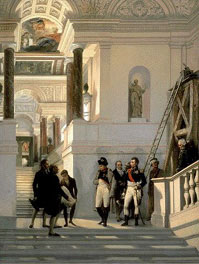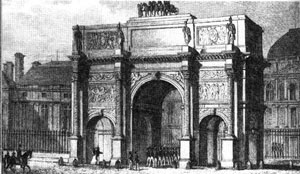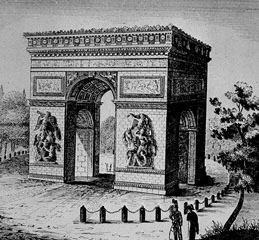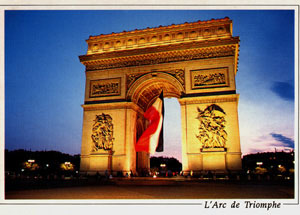|
| TRIUMPHAL ARCHES OF PARIS |
Triumphal arch on the square of Carrousel
(Arc de Triomphe du Carrousel)
 Napoleon, Persier and Fontain. Painted by Coudre.
Napoleon, Persier and Fontain. Painted by Coudre.
|
In 1802, during the Peace of Amiens, in commemoration of the great victories of French arms, it was decided to erect a triumphal arch in Paris on the model of the arches of ancient Rome. Architects Charles Percier (1764-1838) and F.L. Fontaine (1762-1853) supervised the construction. It was begun in February 1806 on the Place du Carrousel, separating the Louvre and the Gardens of Tuileries. The name of this square comes from the festive equestrian competitions of the royal court in the seventeenth century, which were the ancestors of modern military parades.
 Paris. The Triumphal Arch and Palace of Tuilleries. Engraving by F. Siren from the original of B. Ferret. 1830.
Paris. The Triumphal Arch and Palace of Tuilleries. Engraving by F. Siren from the original of B. Ferret. 1830.
|
The arch of Septimus Severus in Rome was taken as the example and two architects erected an Órch 14,60 m high, 17,60 m long, and 10 m wide. Eight soldiers of different armies crown the pillars; and allegories and scenes of the victories of Napoleon's army at Ulm and Austerlitz are depicted on the bas-reliefs.
In April 1808 the Quadrige was erected on the top of the arch. Until this time, it had decorated the facade of Saint Mark's church in Venice). In the thirteenth century, this antique sculpture had been taken to Venice after the capture of Constantinople.
The dedication of the triumphal arch of Carousel took place on August 15,1808.
After the Restoration, the Quadrige was brought back to Venice, and since that time the arch has been crowned with the sculptural group made by F.J.Bosio (1768-1853), 3 meters in size. These four horses convey the goddess Victory, symbol of the Restoration, accompanied by allegorical figures.
Triumphal Arch on the square of Star (Arc de Triomphe de l'Etoile)
Napoleon decided to erect two triumphal arches in Paris in 1806 as the monuments to the glory of French arms. He choose two places for these arches: the Place du Carrousel and the beginning of the Rue Saint-Antoine. the latter location was not aptly chosen: After construction, the arch would have significantly hampered the flow of traffic. Finally, the construction was moved to the Place de l'Etoile (since 1970 - the Place Charles de Gaulle), at the beginning of Champs Elysees, a favorite place for Parisians to stroll.
 Triumphal Arch on the Place de l'Etoile. Engraving.
Triumphal Arch on the Place de l'Etoile. Engraving.
|
The cornerstone of the arch was laid on August 15, 1806. Architect J.F. Chalgrin was in charge of the construction. After his death in 1811 an other architect Guste continued the work, which was suspended in 1814 after the collapse of the Empire, by which time the arch had reached twenty meters in height.
The construction was finally completed during the reign of King Louis-Philippe. The dedication of the arch took place on July 29, 1836.
The arch is 50 m high and 45 m wide.
The arch is decorated by an ensemble of reliefs made by famous French sculptors and representing the most significant moments of the Wars of the French Revolution and the Napoleonic Wars:
 L'Arc de Triomphe. Photo J. Marin.
L'Arc de Triomphe. Photo J. Marin.
|
On the inner walls of the arch are carved the names of 558 generals who participated in the battles of the Wars of the French Revolution and the Napoleonic Wars.
From the top of the arch you can see the entire city. The grave of the Unknown Soldier is located under the central vault of the arch. Military parades begin here.
In 1840 the funeral procession accompanying the remains of Napoleon I to the captial passed under this arch.
In 1885 triumphal arch was covered by black crepe for an entire day as a token of mourning for the great French writer Victor Hugo, son of a Napoleonic general.
Under the arch passed the processions accompanying the presidents of France on their final journey.
© 1998-2002, The team of the Project 1812. Text prepared by Oleg Poliakov. Translated by Maxim Gontcharov. Edited by Annette Kavanaugh.